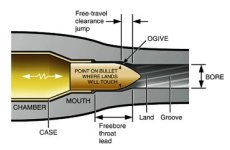Some of the common terms used in Benchrest:
Chamber Body: This is the portion of the chamber that holds the pressure by containing the expanding body of the brass case as it seals against the chamber walls.
Chamber Shoulder: This is the portion of the chamber that acts as a positive stop as the case seats when the bolt closes.
Chamber Neck: This is the part of the chamber that helps align the bullet in the chambered round with the lands and grooves in the barrel. In Benchrest Rifles, we keep the overall neck clearance at just enough to allow for a consistant bullet release, but not so loose as to overwork the brass as it expands. Most Benchrest Shooters will use around .0015 to .002 loaded round to chamber neck clearance when the case is chambered. Of course, to establish such close tolerances, we actually turn the OD of the neck so trhat it is consistant in it's wall thickness.
Chamber freebore: Sometimes called "throat length", this is the small distance between where the neck ends and the lands begin. It can be anywhere from "zero" to way out there. The most common throat lengths use in 100-200 yard Benchrest are between .020 and .070. The throat length that many shooters use is determined by the bullet chosen and where the shooter wants the base of the bullet to end up in the neck of a loaded round.
Lead: This is the tapered portion of the chamber, after the freebore, that allows the bullet to have a smooth transition into the lands. 1.5 degrees is probably the most popular, but some shooters use varied angles that they believe works for them.
Headspace: This is actually a measurement established by The Small Arms and Ammunition Manufacturers Institute, (SAAMI), that determines where the positive stop in the chamber should be. By positive stop, I mean how far into the chamber a loaded case goes. It is the distance from the boltface to a line that is pretty much 1/2 way down the shoulder in a typical rimless bottleneck case. In a rimmed case, it is the distance between the breech block or boltface to the face of the barrel. In a belted magnum, it is the distance from the boltface to the inside of the counterbore that encases the belt. In a straightwall pistol case with a rebated rim, it is the distance from the breech block to the end of the chamber. Keep in mind, it is a measurement that is established world wide so that a Rifle or Pistol built in one part of the world can chamber and safely shoot ammunition that is perhaps manufactured years before and thousands of miles away.
To Benchrest Shooters, what we usually mean by "headspace" is the distance between the face of the loaded round and the bolt face. The reason we do this is because many Benchrest Chambers are not "standard". But, keep in mind, once we fireform our cases into our chamber, we can establish the 'headspace' at any distance we wish. Most Benchrest Shooters adjust their sizing die so that when the case comes out, there will be around .001 clearance between the face of the case and the face of the bolt. Technically, this is not "Headspace", it is head distance. Many even get their panties all in a wad when we call it "headspace" But, we have sort of "bastardized" the term for our own needs.
Hope this helps..........jackie
 by some termonology about chambers. E.G.: Headspace, Free Bore etc., and was wondering if anyone has a anatomical drawing, w/descriptions, of a chamber.
by some termonology about chambers. E.G.: Headspace, Free Bore etc., and was wondering if anyone has a anatomical drawing, w/descriptions, of a chamber.

